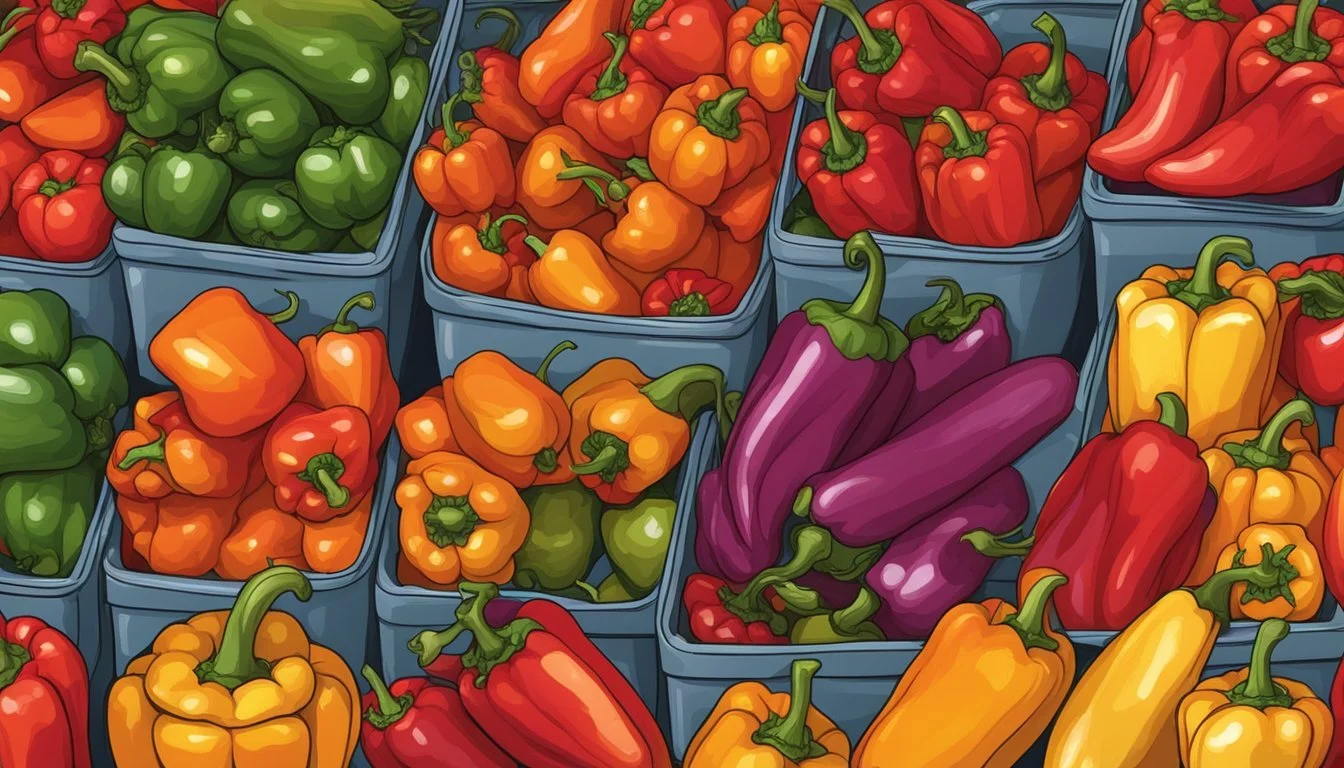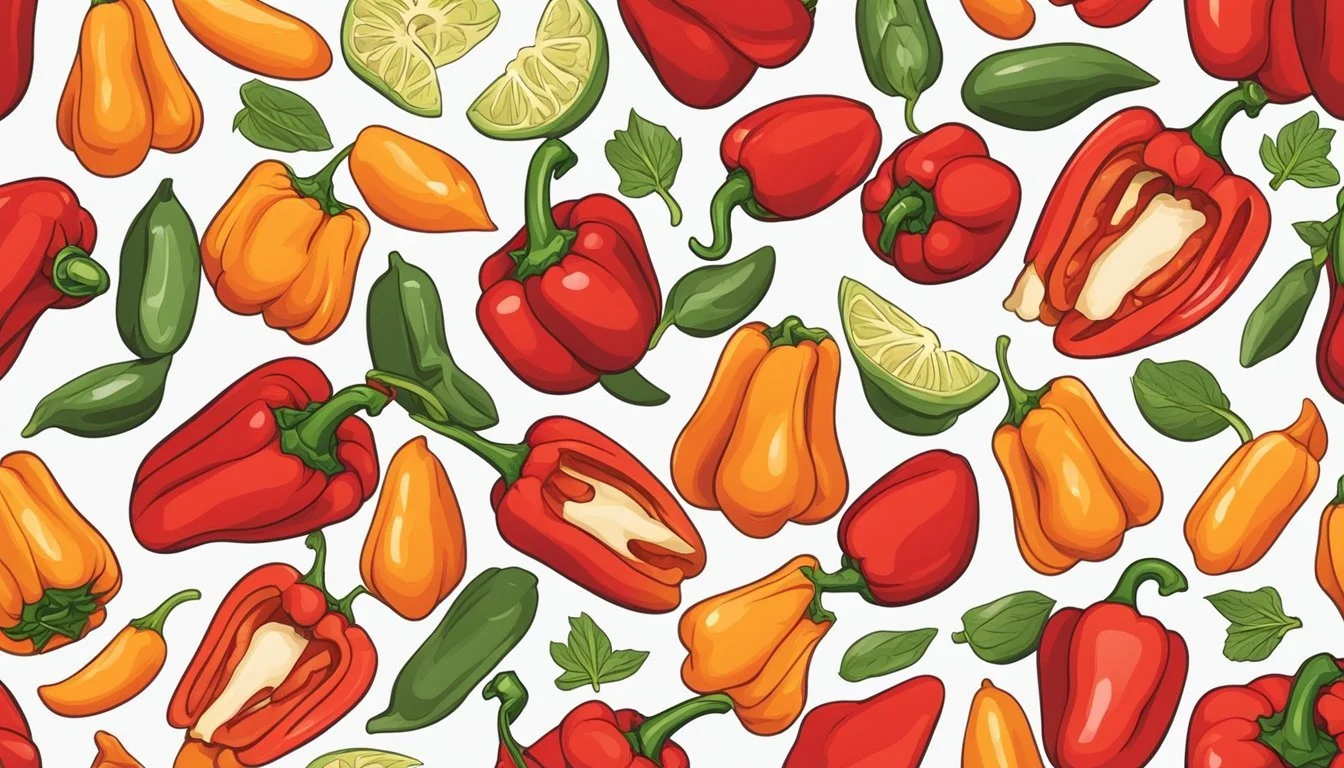Red Pepper Substitutes
Top Alternatives for Spicy Cooking
In the culinary world, red peppers stand out for their vibrant color and distinct sweet yet slightly tangy flavor. They are a versatile ingredient used in a variety of dishes to enhance taste, add a pop of color, and deliver a nutritious boost. However, there are numerous scenarios where a cook might need a substitute for red peppers. Whether due to dietary restrictions, availability issues, or a desire for a different taste profile, finding an alternative is often necessary.
A host of other vegetables and spices can step in as red pepper substitutes, each bringing its own unique flavor and texture to a dish. For instance, broccoli can replace red bell peppers in stir-fry recipes, contributing a more robust structure and a slightly bitter taste. For those looking to replicate the heat of red pepper flakes without the pepper itself, spices such as hot paprika or chipotle powder offer a smoky warmth and color closely mirroring the original ingredient.
The key to a successful substitution is understanding the role that red peppers play in a recipe and selecting an alternative that satisfies that need. Whether the goal is to maintain a similar color, texture, or level of spiciness, there is a range of options available. Cooks can experiment with these alternatives to achieve a satisfying result that keeps their dishes vibrant and flavorful without compromising on taste or presentation.
Understanding Red Peppers
In exploring red peppers, it's fundamental to discern their varieties, the distinct flavor profile they possess, and the health benefits they offer.
Types of Red Peppers
Red peppers, a vibrant and versatile ingredient, encompass a spectrum of peppers ranging from the mild bell pepper to the intense cayenne. Bell peppers, belonging to the Capsicum annuum species, are widely recognized for their hollow, rounded shape and sweet taste. In contrast, cayenne peppers are slender, fiery varieties commonly dried and ground into cayenne spice. These different types of red peppers, including sweet paprika and various red chili peppers, provide a plethora of options for culinary use.
Flavor Profile of Red Peppers
Each type of red pepper brings with it a signature flavor that can be characterized as ranging from sweet to spicy. Bell peppers have a crisp, subtly sweet taste, whereas red chili peppers such as cayenne offer a sharp, robust spice. Paprika, made from dried bell peppers, can vary from sweet to hot, coloring dishes with its mild, smoky essence.
Health Benefits of Red Peppers
Red peppers are more than just a colorful addition to a meal; they're packed with vitamins and capsaicin, the latter known for its anti-inflammatory properties. Bell peppers are an excellent source of Vitamin A and Vitamin C, contributing to immune system health and skin integrity. The capsaicin content in hot red peppers like cayenne is noted for its metabolism-boosting qualities and has been studied for its potential in pain relief and reducing blood cholesterol levels.
Common Red Pepper Substitutes
Selecting an appropriate red pepper substitute is essential for achieving the desired heat level, finding a readily available alternative, matching the flavor profile, or opting for either vegetable-based or non-vegetable-based options, depending on dietary preferences and cooking requirements.
Substitutes Based on Heat Level
For those desiring to maintain the heat intensity of a dish, cayenne peppers or ground cayenne can be an excellent choice, as they offer a similar spicy kick to red chili flakes. Serrano and jalapeno peppers are suitable for fresh applications when a moderate level of heat is preferred.
Cayenne Pepper: Use 1/2 to 3/4 as much depending on heat preference.
Serrano Peppers: Dice to substitute for heat with a fresh flavor.
Substitutes Based on Availability
If the aim is to find a substitute that is easily available, paprika and chili powder are staples in many pantries and can step in for red pepper. These ingredients work well when one is out of red chili flakes or looking for something less spicy.
Hot Paprika: Matches heat and adds color.
Chili Powder: Often contains a blend of spices along with chili.
Substitutes Based on Flavor Profile
To mimic the complex flavor profile of specific red peppers like chipotle or ancho, which contribute more than just heat, use closely related dried peppers or a smoky variation of paprika.
Ancho Powder: Offers a sweet, mild heat.
Chipotle: Provides a smoky flavor that chipotle is known for.
Vegetable-Based Substitutes
For those seeking alternatives within the vegetable family, green bell peppers or poblano pepper can be utilized for their similar texture without adding the heat. Broccoli is a unique yet healthful option that holds its shape while stir-frying, albeit with a different taste profile.
Green Bell Pepper: Provides texture without heat.
Poblano Pepper: A milder flavor for heat-sensitive palates.
Non-Vegetable-Based Substitutes
Aside from vegetables, other non-veg substitutes include dried chili peppers or pequin chili pepper—excellent for their distinct heat levels. When opting for dried varieties, the amount used should be adjusted to ensure the right level of spiciness.
Dried Chili Peppers: Utilize in a ground form for a concentrated heat.
Pequin Chili Pepper: A little goes a long way with this hot substitute.
Culinary Applications of Substitutes
In the quest for the perfect taste, cooks often seek to replicate the heat and flavor of red chili peppers. The following subsections explore how to use substitutes in recipes, craft balanced flavor profiles, and pair them harmoniously with other ingredients.
Using Substitutes in Recipes
Chefs may incorporate substitutes for red chili peppers to achieve a desired level of heat. Dried Poblano peppers, or Ancho chilies, offer a milder heat and can be used in place of red chili peppers, particularly in Mexican dishes like mole or enchiladas. For more intense heat, one might opt for Cayenne pepper or Thai chili pepper in recipes requiring a fiery kick, such as in salsas or marinades.
In contrast, red bell peppers provide sweetness without the heat, making them suitable for rice dishes or pasta sauces where a milder flavor is preferred. Paprika can lend both color and a gentle smokiness, fitting for rubs on meats or a subtle addition to pizza toppings.
Creating Balanced Flavor Profiles
Balancing the replacement's flavor profile with the acidity of ingredients like vinegar or the pungency of onions ensures the dish retains complexity. When substituting for red chili, one must consider the sweetness, bitterness, and overall flavor harmony. Chipotle powder imparts a smoky flavor, pairing well with sweet elements such as orange or rich foods, perfect for fajitas or barbecues.
Substitute Pairings with Ingredients
Finding complementing pairings further elevates food. Bright jalapeños pair nicely with fresh herbs and are readily available at any grocery store. Black pepper and cayenne create a dynamic duo for diverse applications, from marinades to rice dishes.
For a burst of color and taste in Italian cooking, a combination of red pepper flakes and black pepper enhances both pizza and pasta. In contrast, the subtlety of paprika meshes well with ingredients that appreciate a softer touch, such as in creamy sauces or casseroles.
Geographic and Cultural Variations
In exploring substitutes for red bell peppers, one encounters diverse options influenced by local cuisines and available regional produce. These substitutes reflect not only the palate preferences but also the agricultural practices unique to different geographies.
Substitutes in Different Cuisines
Mexican Cuisine: In Mexican dishes, the poblano pepper serves as a common substitute for red bell peppers, offering a milder heat and a deep, earthy flavor. It's frequently roasted and used in a range of recipes from chiles rellenos to mole sauces.
Chinese Cuisine: Northern China often utilizes the Chinese red pepper or Tien Tsin pepper, which imparts a sharp spiciness suitable for Kung Pao Chicken and Sichuan dishes. In contrast, sweet bell peppers may be found in more Western-influenced Chinese recipes.
Indigenous Substitutes by Region
South America: Here, the ají dulce, a small, sweet variety, is favored for its likeness to bell peppers without the spicy kick. This makes it an ideal bell pepper stand-in for stews and sofritos.
Grocery Stores: Due to globalization, regional substitutes can often be found in the ethnic sections of grocery stores, allowing for authentic ingredient use even beyond the borders of their origin. For instance, ají amarillo paste can sometimes be used as a bell pepper alternative, providing a vibrant, fruity taste typical of Peruvian cuisine.
Region Common Substitutes Mexico Poblano Pepper Northern China Chinese Red Pepper, Tien Tsin Pepper South America Ají Dulce Global Grocery Stores Access to various regional substitutes
Shopping for Red Pepper Substitutes
When red pepper flakes are unavailable or unsuitable for a dish, shoppers can find a variety of substitutes at local grocery stores that offer different flavor profiles and heat levels.
Finding Substitutes in Grocery Stores
One can typically find sweet substitutes, such as bell peppers or paprika, in the spice aisle of most grocery stores. These are milder options and suitable for palates averse to intense heat. For a modest kick, jalapeños provide a fresh alternative that is readily available in the produce section. They should look for vibrant color and firm texture to ensure freshness.
While in the spice aisle, shoppers may also come across chili powder, which offers a complexity of flavor with a modest heat level, similar to that of red pepper flakes. It's important to read the labels, as chili powders can vary widely in heat and composition.
Grocery Store Aisles for Red Pepper Substitutes:
Substitute Aisle Notes Bell Peppers Produce Look for firm, vibrant peppers Jalapeños Produce Select for moderate heat Paprika Spice Opt for "hot" for more heat Chili Powder Spice Varies in heat; sample sparingly
Selecting Quality Substitutes
When selecting a substitute, shoppers should consider the desired heat level and flavor. They need to inspect the spices for a bright color and aromatic smell, which indicates freshness and quality. Fresh peppers like jalapeños should have a glossy skin without blemishes.
Quality Checklist:
Bell Peppers: Firm, no wrinkles, bright color
Jalapeños: Glossy, unblemished skin, firm to touch
Spices: Check for use-by dates, bright color, and strong aroma
By carefully selecting substitutes, cooks can seamlessly adjust the flavor of their dishes to meet their specific taste preferences while shopping at their regular grocery stores.
Preparing and Cooking with Substitutes
When a recipe calls for red pepper flakes, one may wonder how to seamlessly integrate a substitute without compromising the original flavor or texture of the dish. The following sections delve into the best practices for handling and storing these alternatives, as well as cooking techniques to maximize their potential in various recipes.
Handling and Storing Substitutes
Hot Paprika: Store hot paprika in a cool, dark place to preserve its vibrant color and spicy flavor. It's a potent substitute for red pepper flakes and should be used in smaller quantities due to its concentrated heat.
Storage: Airtight container in a dark cupboard
Shelf Life: 6 months for optimal potency
Chipotle Powder: With its smoky taste, chipotle powder requires careful handling to prevent overpowering the food.
Storage: Sealed container away from light and heat
Shelf Life: Up to a year if stored properly
Cayenne Pepper Powder: Known for its intense heat, a little goes a long way.
Storage: Dry place in a tightly sealed jar
Shelf Life: Best used within six months for maximum heat retention
Chili Powder: Store in a cool, dark environment. Due to its blend of ingredients, its shelf life may be shorter than pure chili peppers.
Storage: Cool, dark shelf in an airtight container
Shelf Life: 3-4 months to maintain a robust flavor profile
Cooking Techniques for Substitutes
When cooking with substitutes like hot paprika or chipotle powder, start with a conservative amount and adjust according to taste, considering the desired level of spiciness.
Hot Paprika:
Application: Ideal for adding both color and heat to dishes such as chicken or pork.
Technique: Add early in the cooking process to allow its flavor to meld with the other ingredients.
Chipotle Powder:
Application: Provides a deep, smoky heat perfect for marinades, sauces, and stews.
Technique: Introduce it midway through the cooking to balance out its dominating flavor.
Cayenne Pepper Powder:
Application: A little adds significant heat, suitable for spicy food enthusiasts. Excellent in dry rubs for meats like chicken and pork.
Technique: Incorporate gradually, tasting along the way to achieve the desired heat level.
Chili Powder:
Application: Complements a wide array of recipes due to its complexity; it offers more than just heat.
Technique: Use it in moderate amounts to start and adjust as the dish progresses, keeping an eye on the evolving flavor profile.
Alternative Spices and Seasonings
When seeking substitutes for red pepper flakes, one can choose between spices that match the heat level and those that add complementary flavors.
Spice Alternatives for Red Pepper Heat
Chili Powder: Chili powder can serve as a milder substitute with a heat level that varies depending on the blend, often incorporating spices such as cumin and garlic.
Cayenne Pepper: For intense heat, cayenne pepper is a direct substitute. It contributes significant warmth with Scoville ratings typically around 30,000 to 50,000 SHU.
Chipotle Powder: With its smoky notes, chipotle powder is suitable for dishes requiring a rich, nuanced spice profile.
Pequin Chili Pepper: They pack a considerable punch, suitable for those who prefer a fiery heat with a higher Scoville scale rating.
Black Pepper: While not as hot, black pepper can be used when a slight piquancy is enough to enrich the dish without overpowering it.
Herbal and Aromatic Alternatives
Anaheim Peppers: For a milder heat, Anaheim peppers provide a more subdued spice level suitable for broader preferences.
Jalapeños: These peppers offer a moderate heat, with fresh jalapeños being less spicy than their dried counterparts such as red pepper flakes.
Harissa: This blend contains hot chili peppers along with aromatic spices and herbs, providing layers of flavor beyond simple heat.
Gochujang: It stands out with its signature savory-sweetness and complexity, adding not just heat but also a depth of flavor to dishes.
Hot Sauce: A liquid option that comes in a vast range of heat levels and flavors allows for adjusting heat while also introducing additional tang or sweetness, often with vinegar or lime juice being part of its composition.
Italicizing the main flavors can guide readers to desirable taste profiles like smoky, tangy, or sweet. Lists aid in visual differentiation between alternatives. Using brief descriptions after each suggestion helps in associating each substitute with a specific quality, like heat level or complexity.
Nutritional Considerations and Allergies
When considering substitutes for red peppers due to allergies or flavor preferences, it's important to assess the nutritional content and presence of capsaicin, which is the component responsible for the heat in peppers. One must also consider the natural sweetness and vitamins provided by peppers, especially the vitamin-rich red and yellow bell peppers.
Allergy-Friendly Red Pepper Alternatives
Individuals allergic to bell peppers should avoid all varieties, including red and yellow, as they contain common allergens. These allergies often pertain to a family of proteins found within the pepper. For a non-allergenic alternative, one can look at root vegetables like carrots or sweet potatoes, which also offer a natural sweetness and are high in vitamins. If avoiding capsaicin is the goal, carrots can mimic the texture without the heat.
Low-Heat Substitutes for Sensitive Palates
For those seeking substitutions with lower heat, one might consider sweet bell peppers, specifically yellow bell peppers, which are milder yet still offer a comparable sweetness and a similar nutritional profile, including vitamins. Another capsaicin-free option to consider would be piquillo peppers, which closely resemble the flavor of roasted red peppers but lack the intense spiciness.






